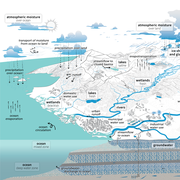Downloadable products
Our latest Water Cycle Diagram is now available!
Check it out and see how humans influence the global water cycle.
The U.S. Geological Survey (USGS) offers you the most comprehensive information about the natural water cycle anywhere, and, our information is available in many languages. Here you can download our water cycle diagrams as well as other educational products to assist you in the classroom or on your own learning adventure!



